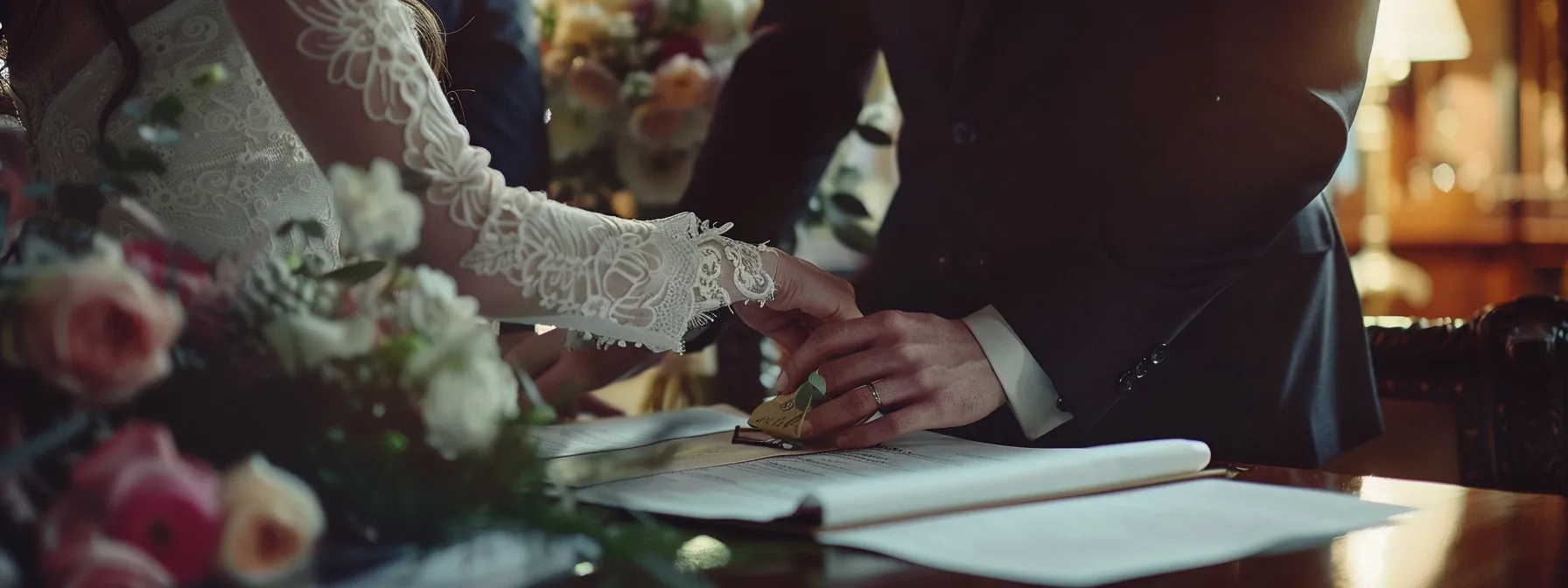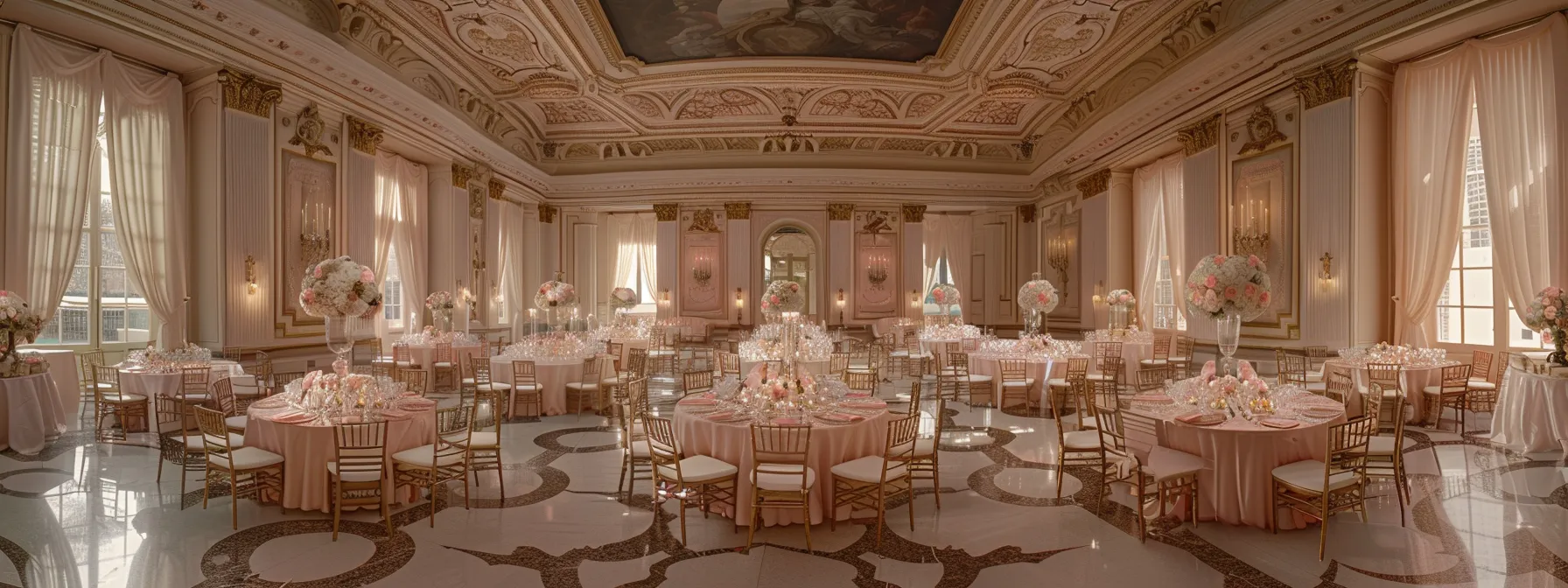Planning a wedding can often feel like navigating through a complex maze, each turn presenting a new challenge. Our guide offers essential steps to set the foundation of your marital celebration, simplifying this intricate process. We will delve into establishing a sensible budget, selecting the perfect date and venue that may range from a sun-bathed beach resort to an elegant urban cocktail lounge, and constructing an initial guest list. Understanding the requirements for a marriage license, choosing a photographer to capture your memorable moments, and designing your ideal floral arrangements are vital elements we’ll cover. Engaging with this content not only answers your pressing questions but also equips you with the clarity and resources needed to make informed decisions every step of the way.
Key Takeaways
- Establishing a wedding budget early helps avoid financial stress and ensures a seamless celebration
- Properly vetting and securing key vendors early sets the tone and prevents last-minute issues
- A contingency fund for unexpected expenses is essential for maintaining budget control
- Clear communication of roles within the wedding planning team is crucial for efficiency
- Meticulously reviewing vendor contracts protects the couple’s interests and investments
Establish Your Wedding Budget

Launching the wedding planning journey hinges on establishing a realistic budget, a crucial step that entails determining who will contribute financially, whether it’s family, the couple, or a combination of both. It is essential to prioritize expenses, balancing the cost of a seasoned wedding planner, a reputable justice of the peace, or perhaps a designer shoe and fashion ensemble. Moreover, it’s wise to allocate funds for unforeseen expenses to ensure the party remains on track irrespective of the challenges that may emerge. This preliminary financial framework sets the stage for a stress-free celebration.
Determine Who Will Contribute Financially
In the initial strides of wedding planning, one pivotal decision is determining the financial contributors—be it family members, the couple, or a combination thereof. Understanding each party‘s ability and willingness to assist with expenses for the ceremony, dinner, and wedding invitation printing is essential. This aids in creating a well-informed spending strategy. Couples should also consider the importance of budgeting for wedding insurance and catering costs, ensuring they’re equipped to navigate any unforeseen circumstances that might impact their special day.
Prioritize Expenses Based on Importance
When drawing up a wedding budget, it is critical to weigh the significance of various expenses to avoid overspending in less impactful areas. The allure of a designer dress, the ambiance created by lush flower arrangements, the energy of dance at the reception, the laughter shared over a spa day for the bachelorette party – all hold unique value. However, it is vital to rank these based on their contribution to the couple’s vision for their day. For instance, should a couple value memories over material, investing in a professional photographer might take precedence over elaborate decor. By prioritizing budget allocation for key elements, couples can enhance their celebration without forfeiting financial security.
- Establishing clear priorities when allocating the wedding budget
- Understanding the couple’s vision to determine the importance of expenses
- Balancing the cost of unforgettable experiences with practical financial planning
Set Aside Funds for Unexpected Costs
Amid the excitement of selecting the perfect venue, meal, and decor, couples should not overlook the importance of reserving funds for unexpected wedding-related expenses. This foresight is crucial, as costs can escalate quickly, from last-minute beauty treatments to additional hotel accommodations for out-of-town guests or a rush fee for a wedding cake. Factoring in a contingency amount addresses these potential financial surprises, ensuring that the essence of the occasion isn’t marred by the stress of unanticipated expense.
| Potential Unexpected Expense | Typical Cost Range | Recommended Contingency Allocation |
|---|---|---|
| Last-Minute Beauty Treatments | $50 – $300 | 5% of Beauty Budget |
| Additional Hotel Accommodations | $100 – $500 per night | 10% of Accommodation Budget |
| Rush Fee for Wedding Cake | $100 – $400 | 15% of Cake Budget |
Choose a Wedding Date and Venue

Selecting an ideal wedding date and venue marks a significant milestone in the planning journey. Couples should first decide on a preferred season or time of year that complements their vision, whether it’s a summer beach ceremony or a winter celebration. Exploring venue options early is essential, as popular locations book quickly; tools like spreadsheets can be invaluable for managing options within the budget. Consider both ceremony and reception locales—in tandem with honeymoon planning and bachelor festivities—to ensure seamless transitions for guests and a memorable experience for all.
Decide on a Preferred Season or Time of Year
When embarking on wedding planning, selecting the season or time of year is a defining moment in crafting the atmosphere of the day. A summer date might lend itself to a vibrant black tie affair, while a cooler climate may inspire the warmth of linen-draped tables and candlelight. Communicating this decision through a wedding website keeps guests informed, and consulting with a wedding planner via their email address can streamline the many logistical considerations that accompany each season. This choice, resonating with the couple’s style, cultivates a mood that will be reflected across every detail of their nuptial celebration.
Explore Venue Options Early
Securing the ideal venue early in the wedding planning process is paramount, as locations that perfectly meld elegance with functionality are in high demand. An early search allows couples to consider venues that not only provide spectacular backdrops for photographs but also offer exquisite entertainment options and a mouth-watering food selection, ensuring that all elements—from the wedding dress and groomsman attire to the restaurant‘s atmosphere—cohesively align to reflect their envisioned day. Being proactive in venue selection can alleviate the stress of last-minute compromises, allowing for a tailored celebration that truly resonates with the couple’s unique style and preferences.
Consider Ceremony and Reception Locations
When planning a wedding, choosing compatibly stylish yet functional locations for both the ceremony and reception becomes a cornerstone decision. A ceremony location that resonates with the symbolic value of the engagement ring sets a profound tone for the day, while the reception venue must cater to practicalities such as cash bars, diverse menu options, and entertainment spaces for a photo booth—all seamlessly tied together with convenient transport options for guests. These selections form the backbone of a wedding‘s ambience and flow, pivotal in enabling the envisioned matrimonial celebration to unfold with grace and joy.
Create an Initial Guest List

Embarking on the path to marriage entails a meticulous selection of guests to witness the union down the aisle. The process begins by listing immediate family and close friends, followed by an estimated guest count, vital for venue selection. Compiling a comprehensive collection of contact information, including details relevant to the buffet, gift logistics, and bridal shower invitations, ensures a seamless invitation process. Navigating these initial steps lays the foundation for a successful event that resonates with the couple’s vision.
List Immediate Family and Close Friends
The journey to a blissful beach wedding begins with drafting an initial guest list, placing immediate family and cherished friends at the heart of your celebration. This list not only shapes the intimate brunches, heartfelt toasts, and meaningful moments at the rehearsal dinner but also plays a critical role in deciding bridesmaid selections and seating arrangements. Having a clear idea of those closest to you ensures each invite is sent with intention, creating a circle of love and support as you step into this new chapter of life together.
Estimate Guest Count to Inform Venue Selection
An accurate estimate of guests is indispensable for orchestrating the wedding venue selection, where the joyous knot will be tied amidst the accompaniment of music and celebrations. A well-considered guest count not only influences the size and location of the venue but also directly impacts budget allocation for food, seating, and entertainment. As couples weave their vision into reality, considering the number of attendees early in the planning ensures an enchanting ambiance without overextending their resources, allowing them to design an event that’s both memorable and fiscally prudent.
Collect Contact Information
Gathering contact information is a fundamental step in wedding planning, integral for managing RSVPs and ensuring guests are informed about the aesthetics of the event, key dates like for obtaining the license, and even preferences for cake flavors. Couples must ensure they have accurate details for each invitee, which enables efficient communication, from the engagement announcement to the final thank-you notes post-celebration. Thoroughly collated contact information underpins the logistical planning, offering a seamless transition through each stage of the journey towards the altar.
Define Your Wedding Style and Theme

Defining a wedding style and theme is pivotal for brides as they venture into the realm of matrimony. The couple’s unique style is reflected in every detail of the day, from the chosen colors to the level of formality. Brides often find inspiration from various sources, aligning their choices with wedding etiquette and personal taste. Selecting a color palette lays the foundation, while deciding the formality dictates the event’s conduct and potential contracts with vendors. Together, these elements shape the wedding‘s aesthetic and atmosphere, ensuring a cohesive and memorable experience for all attendees.
Gather Inspiration From Various Sources
Embarking on the design phase of a wedding mandates seeking inspiration from an array of sources to distill the essence of the couple’s style and thematic preferences. One may look to bridal magazines, wedding blogs, and social media platforms all brimming with visuals that spark the imagination for color schemes, venue decorations, and attire. This expansive search not only delivers a wealth of ideas but can be the catalyst for discovering a unique blend of elements that personalize the celebration, resonating with the couple’s tastes and the jubilant spirit they aspire to share with their guests.
Select a Color Palette That Reflects Your Vision
Selecting the right color palette is a fundamental element in crafting your wedding‘s visual narrative. It shapes every aspect, from invitations and bridal party attire to table settings and floral arrangements. When choosing hues, consider the emotion and ambience you wish to evoke: soft pastels might suggest a light, romantic air, while bold shades could create an atmosphere of vibrancy and celebration. Couples should opt for colors that not only suit their personal tastes but also harmonize with the venue and season, ensuring a cohesive and enchanting wedding day tableau.
- Reflect on the emotional tone desired for the wedding day.
- Choose colors that complement personal style and the wedding environment.
- Consider the interplay of palette choices with the venue’s existing hues and the season.
Decide on the Formality Level of the Event
In the tapestry of wedding planning, deciding the formality of the event is a canvas upon which the entire day’s mood is painted. The couple must contemplate whether their celebration will be a black-tie affair, a semi-formal event, or a casual beach gathering, each setting a distinct tone for attire, venue choice, and overall ambiance. This decision influences vendor contracts and guest expectations, ensuring that the experience seamlessly embodies the couple’s vision for a day that articulates their notion of togetherness and jubilation.
Build Your Wedding Planning Team

As couples embark on the intricate process of wedding planning, building a robust team is paramount. The consideration of hiring a professional planner can provide organizational expertise, while delegating tasks to trusted friends and family helps distribute the workload. Clearly communicating roles and responsibilities is crucial for ensuring that every team member contributes effectively to the realization of the wedding day’s vision. Together, these steps forge a collaborative and efficient planning experience.
Consider Hiring a Professional Planner
Considering the addition of a professional planner to your wedding team could prove invaluable. They bring a wealth of experience and organizational skills that streamline the planning process, expertly navigating vendor negotiations, scheduling, and budget management. Entrusting these complexities to a seasoned planner not only alleviates stress but also offers the couple peace of mind, allowing them to focus on the joy of their upcoming nuptials.
Delegate Tasks to Trusted Friends and Family
When entering the complexity of wedding coordination, delegating tasks to trusted friends and family can significantly ease the burden on the couple. These allies can manage various aspects, such as overseeing the guest list coordination, orchestrating transportation logistics, or handling day-of emergencies. This division of labor allows the couple to immerse themselves in the joys of their celebration, confident in the knowledge that each critical component is in the hands of capable loved ones.
Communicate Roles and Responsibilities Clearly
Clear communication regarding roles and responsibilities within the wedding planning team is fundamental to coordinate efforts harmoniously. When each member, from the event coordinator to family volunteers, understands their specific tasks, the planning process becomes more streamlined and efficient. As the wedding date approaches, this clarity can prevent misunderstandings and ensure every detail is managed with proficiency, contributing to a seamless and memorable matrimonial event.
Begin Researching and Booking Vendors

Moving forward in the wedding planning process, couples face the crucial task of selecting priority vendors such as caterers and photographers who will play a central role in shaping their special day. It is essential to schedule meetings and site visits to ensure services align with expectations. Reviewing contracts with a meticulous eye before finalizing agreements is non-negotiable to prevent any potential complications. These proactive steps are the foundation for creating a day that reflects the couple’s vision with precision.
Identify Priority Vendors Like Caterers and Photographers
In the early stages of wedding planning, identifying and securing priority vendors such as caterers and photographers is critical. These professionals are instrumental in capturing the essence and flavor of your celebration. It’s important to research their portfolios and client reviews, schedule tastings and consultations, and ensure their availability aligns with your wedding date. Making these choices early helps set the tone and style of the event, providing peace of mind that these essential aspects are in expert hands.
- Research vendor portfolios and read client testimonials to gauge quality and reliability.
- Arrange tastings with caterers to ensure their offerings meet your taste preferences and dietary requirements.
- Schedule consultations with photographers to discuss your vision and confirm their understanding of your style.
Schedule Meetings and Site Visits
Scheduling meetings and site visits is a critical phase in the vendor selection process, providing couples with the opportunity to assess venues and caterers firsthand. This engagement enables them to visualize their event in the space, gauge the professionalism of the staff, and gain clarity on logistical details crucial for a seamless celebration. By interacting directly with vendors, they can communicate their vision clearly, establish rapport, and negotiate aspects tailored to their needs, ensuring each vendor is a perfect match for their wedding day.
| Vendor Type | Action Items | Outcome Expected |
|---|---|---|
| Venue | Schedule walk-through and discuss layout options | Find a space that aligns with the wedding theme and guest capacity |
| Caterer | Arrange tasting and review menu options | Select a menu that satisfies taste preferences and dietary considerations |
| Photographer | Organize a portfolio review and discuss event coverage | Ensure a visual style and approach that resonates with the couple |
Review Contracts Thoroughly Before Committing
Before fully committing to any wedding vendors, it’s crucial to meticulously review their contracts. These documents should detail every aspect of the services provided, including cancellation policies, deposit amounts, and precise deliverables. Ensuring that agreements align with expectations not only safeguards financial investment but also secures peace of mind. A professional planner can provide valuable guidance in navigating contract particulars, translating legal jargon into clear terms and assisting in negotiating favorable conditions for the couple’s paramount day.
| Vendor | Key Contract Details | Action Required |
|---|---|---|
| Photography Services | Event coverage hours, delivery timeframe for photos, rights of usage | Verify the photographer will capture all desired moments and check for hidden costs |
| Catering | Menu items, cost per head, dietary accommodations, setup and cleanup services | Confirm menu details, including any special requests, and understand service scope |
| Entertainment | Performance duration, equipment provided, song requests and prohibitions | Clarify performance expectations and confirm all technical requirements are met |






